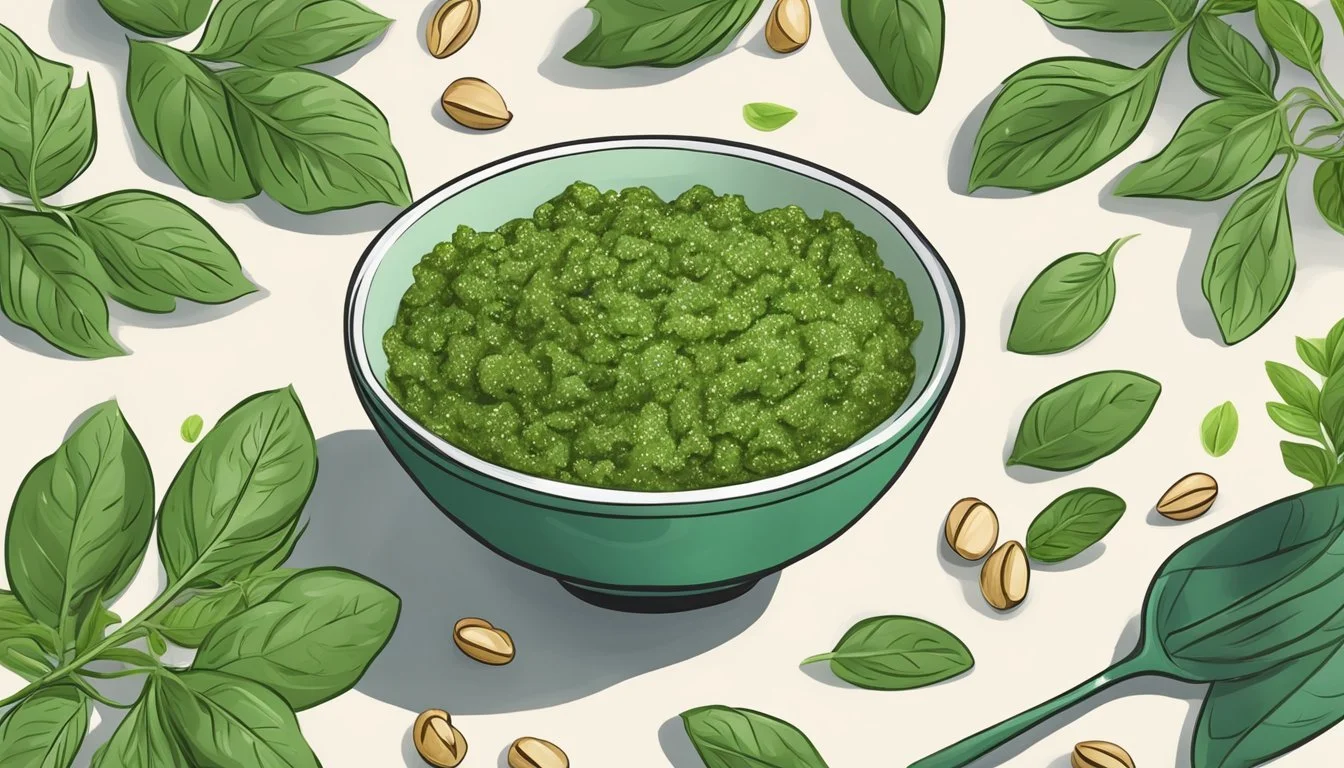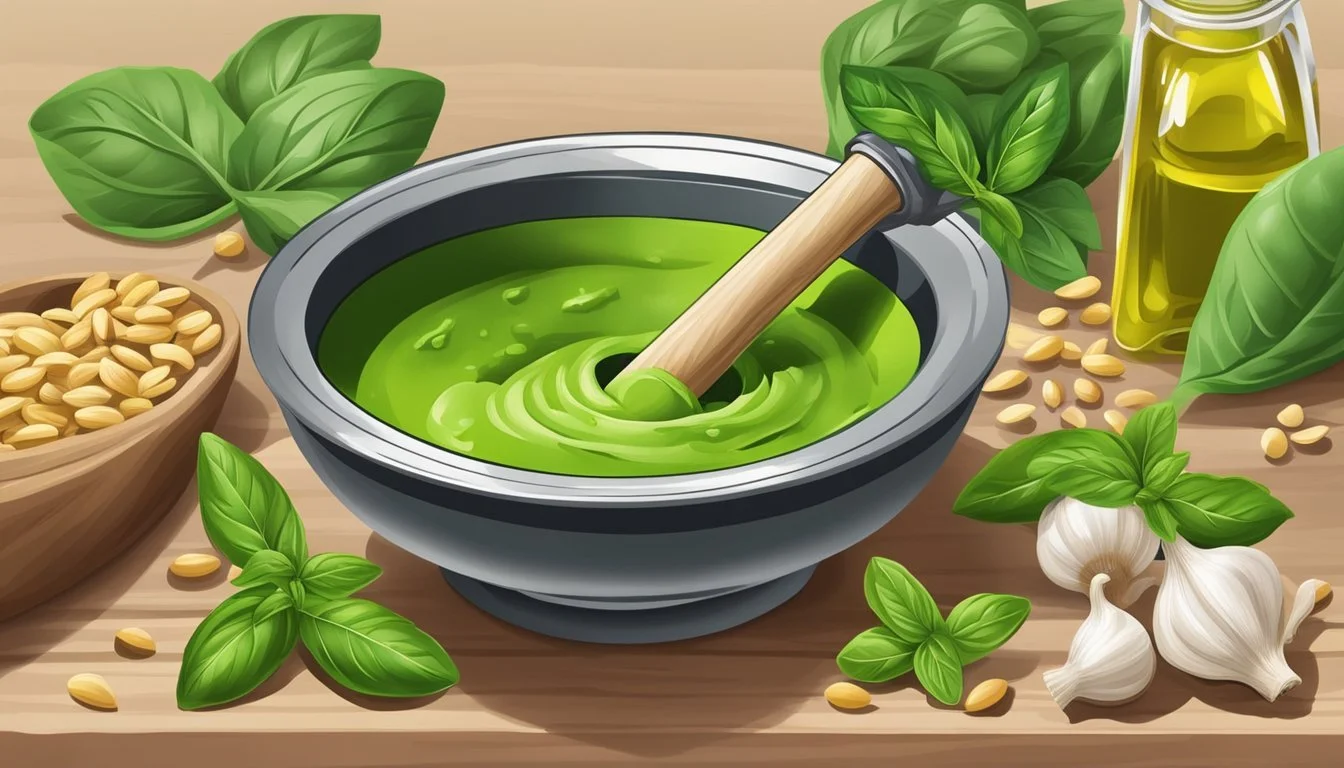Is Pesto Vegan?
Unveiling the Truth About This Classic Sauce
Pesto is a vibrant green sauce that traditionally hails from Italy, known for its rich flavor and versatility in the kitchen. While classic pesto is made with a combination of basil, pine nuts (What wine goes well with nuts?), garlic, Parmesan cheese, and olive oil, the use of cheese means it's not suitable for vegans. However, there's good news for those following a plant-based diet. The increasing demand for vegan products has led to the creation of numerous vegan pesto varieties.
Vegan pesto swaps out the Parmesan for alternative ingredients such as nutritional yeast or vegan cheeses to replicate the savory flavor profile. Some recipes might also introduce other greens, like kale or cashews, to add depth and nutritional value. Organic brands often offer a range of vegan pestos, ensuring that all the ingredients are plant-based, from the oil to the nuts. This adaptation allows vegans to enjoy the richness of pesto without compromising on their dietary choices.
The key to identifying vegan pesto is to carefully inspect the label for non-vegan ingredients such as cheese. For those preferring a homemade touch, creating vegan pesto at home is a simple and quick process, requiring just a few plant-based substitutes readily available at most grocery stores. Whether buying off the shelf or making it from scratch, vegans have a variety of options to enjoy the hearty flavor of pesto in their cooking.
Understanding Pesto
Pesto is a beloved Italian sauce known for its vivid color and rich flavor, traditionally made with a blend of fresh ingredients.
Ingredients of Traditional Pesto
Traditional pesto, or pesto alla genovese, hails from Genoa in the Liguria region of Italy. The classic recipe calls for a few key ingredients:
Basil: Fresh basil leaves provide the signature herbal flavor.
Cheese: Finely grated hard cheeses such as Parmigiano-Reggiano or Pecorino add a savory depth.
Pine nuts: These are crushed to give body and a nutty essence.
Garlic: A small amount is used to infuse a pungent kick.
Olive oil: Extra virgin olive oil binds the ingredients and adds smoothness.
Origins and Varieties
Pesto's origins can be traced back to Genoa, and the sauce is a testament to the simple, rustic cuisine of the region. While Genovese remains the archetype, various pesto varieties have emerged, including:
Red pesto: Utilizing sun-dried tomatoes or red peppers in place of or alongside basil.
Vegan pesto: Omitting cheese or substituting it with nutritional yeast or vegan cheese alternatives.
Nut-free pesto: Replacing pine nuts with seeds such as sunflower or pumpkin seeds to accommodate allergies.
Contrary to other versions, the traditional Genovese pesto is rarely vegan due to its inclusion of cheese. However, the adaptability of pesto recipes allows them to be customized to suit different dietary requirements.
The Vegan Pesto Alternative
Vegan pesto replaces traditional ingredients like cheese with plant-based substitutes while maintaining the classic pesto flavors. It offers a dairy-free option suitable for vegan diets without compromising on taste or versatility.
Key Ingredients
Basil: The foundation of pesto, providing a fresh and peppery taste.
Nuts: Pine nuts are traditional, but walnuts or cashews can be used.
Garlic: Essential for the characteristic pesto zing.
Extra Virgin Olive Oil: Acts as a binder and adds richness.
Nutritional Yeast: Offers a cheesy flavor without dairy.
Acidic Component: Lemon juice provides brightness and balance.
Vegan Cheese Alternatives
Nutritional Yeast: A staple for mimicking the umami flavor of cheese.
Vegan Parmesan: Available in stores or made from ground nuts and nutritional yeast.
Vegan Pesto Variations
Herb Substitutes: Parsley, arugula, spinach, or kale can replace or complement basil.
Oil Variations: Some may opt for alternative oils like avocado for a twist on the traditional olive oil.
Culinary Uses of Pesto
Pesto, traditionally a blend of basil, pine nuts, garlic, cheese, and olive oil, expands its versatility in the kitchen beyond its role as a classic pasta companion. The sauce's rich flavor profile lends itself to various culinary applications, elevating simple dishes with its fresh and aromatic character.
Integrating Pesto into Meals
Pesto sauce effortlessly infuses meals with its distinctive basil taste and nutty undertones. It is commonly stirred into hot pasta dishes where it coats the noodles, imparting a vibrant green hue and robust flavor. Equally at home atop pizza, pesto can replace tomato sauce as a base or serve as a flavorful drizzle after baking. Additionally, chefs often incorporate it into sandwich spreads, adding layers of flavor to paninis and wraps.
Pasta & Pizza: Pesto serves as a primary sauce or a flavor enhancer.
Bread: Swirling pesto into bread dough or using as a spread on toast offers a twist to traditional servings.
Salad: It can be dressed on fresh greens or pasta salads for an aromatic touch.
Soup: A dollop of pesto on top of soups can provide a burst of freshness.
Pesto as a Base for Other Sauces
Innovative cooks use pesto as a foundational element to craft other sauces. By mixing pesto with ingredients such as cream, yogurt, or mayonnaise, one can create a variety of dressings and dips suitable for salads, appetizers, and sides. Pesto-based salad dressings invigorate greens with an Italian flair, while as a dip, it brings a concentrated burst of flavor to crudités and crackers.
Salad Dressings: Combining with vinaigrettes or creamy bases to create new flavors for salads.
Dips: Pesto blends with sour cream or other dip bases for a rich, herbaceous appetizer.
Health and Nutrition
This section explores the nutritional composition of pesto and the potential health benefits it provides when incorporated into a vegan diet.
Nutritional Profile
Calories: Traditional pesto contains about 80-90 calories per tablespoon due to its rich ingredients.
Carbohydrates: A typical serving has roughly 1 gram of carbohydrates.
Protein: Provides around 1 gram of protein per tablespoon.
Fats: Comprises 8 grams of fat, which include:
Monounsaturated fats: 3.5 grams
Saturated fats: 1.5 grams
Polyunsaturated fats: 1 gram
Vitamins and Minerals:
Vitamin A: Essential for vision and immune function.
Vitamin C: Crucial for the synthesis of collagen and immune defense.
Calcium: Key for bone health.
Iron: Vital for oxygen transport in the blood.
Health Benefits
Heart Health: The monounsaturated fats from olive oil are associated with good heart health.
Satiety: High-fat content, primarily healthy fats, can contribute to a feeling of fullness.
Bone Strength: Provides calcium, which is beneficial for maintaining bone density and strength.
Vitamin Absorption: Fat content aids in the absorption of fat-soluble vitamins like A, D, E, and K.
Pesto's nutritional benefits make it a healthful addition to a vegan diet, particularly with regard to fats, vitamins, and minerals.
Homemade Vegan Pesto
Creating homemade vegan pesto allows control over ingredients for a healthful and delicious condiment. Traditional pesto calls for cheese, but one can easily substitute plant-based ingredients without compromising the vibrant basil flavor or creamy texture.
Recipe Tips
An ideal vegan pesto recipe combines fresh basil for its quintessential fragrance and green hue, while substituting cheese with nutritional yeast for a cheesy flavor profile. Garlic, lemon juice, and sea salt are essential for achieving the bold pesto taste. When blending, a food processor provides the best results, creating a smooth, spreadable sauce.
Basics: Always start with fresh ingredients for the most potent flavors.
Blending: Pulse ingredients for better control over texture.
Seasoning: Adjust lemon juice and salt gradually, tasting as you go.
Customization Ideas
Vegan pesto is highly customizable with various nuts and additional ingredients:
Nuts: Try walnuts, almonds, or cashews as affordable pine nut alternatives.
Green Variations: Spinach or kale can complement or replace basil for a nutrient boost.
Nutritional Yeast: Add this for a cheesy flavor without the dairy.
Here's how one might customize the flavor profile:
Ingredient Purpose Suggested Quantity Walnuts For a nutty, earthy flavor 1/2 cup Almonds For a slightly sweet undertone 1/2 cup Cashews For creaminess 1/2 cup Lemon Juice For brightness and acidity 2 tablespoons Nutritional Yeast For cheesy flavor 1-2 tablespoons
Food Processor Use
A food processor is essential for achieving a smooth and well-emulsified homemade pesto. It's recommended to start with nuts and garlic, pulsing them until finely chopped before adding other ingredients. Here's a simple guide for food processor use:
Blend Nuts and Garlic: Start by pulsing nuts and garlic to avoid large chunks.
Add Basil: Introduce basil gradually, as overfilling can lead to uneven blending.
Stream In Oil: While the food processor is running, slowly stream in the oil to emulsify.
Scrape Down Sides: Occasionally stop to scrape down the sides for uniform texture.
Final Taste: Give it a final taste and adjust the seasoning as needed before serving.
A food processor makes it easy to adjust the texture of the pesto, from coarse to smooth, according to one's preference.
Storing and Preserving Pesto
Proper storage methods are crucial in maintaining the freshness and flavor of pesto. Whether it is vegan pesto or otherwise, understanding how to refrigerate and freeze pesto can greatly extend its lifespan.
Refrigeration and Freezing Tips
Refrigeration:
When refrigerating pesto, it is best to place it in a small, airtight container.
Pouring a thin layer of olive oil on top before sealing can prevent oxidation, keeping the pesto greener for longer.
Pesto should be used within 3 days from the refrigerator to ensure optimal taste.
Freezing:
For longer preservation, pesto freezes well in ice cube trays.
Once frozen, transfer the cubes to freezer bags or containers, limiting light and air exposure.
They can be stored in the freezer for up to 3 months for best flavor.
Shelf-Life Maximization
Tips for maximizing pesto's shelf-life:
Always use clean utensils when handling pesto to prevent contamination.
Make sure the refrigerator or freezer is set to the appropriate temperature, which is typically 4°C (40°F) for the fridge and -18°C (0°F) for the freezer.
Label your pesto with the date of storage to keep track of its shelf-life.
If you notice any odd smell or discoloration, it's best to dispose of the pesto to prevent foodborne illness.
By adhering to these storage guidelines, one can ensure their pesto remains as fresh and flavorful as possible. Whether it’s leftovers or a fresh batch, proper storage can make all the difference in the longevity of pesto.
Pesto Without Nuts
Pesto is a versatile sauce traditionally made with pine nuts, but for those with allergies or dietary preferences, nut-free versions are a delicious alternative.
Nut-Free Ingredient Options
For a nut-free pesto, seeds such as sunflower seeds or pepitas (pumpkin seeds) serve as excellent substitutes. They provide a similar texture and richness to the sauce:
Sunflower seeds: Mild and slightly nutty in flavor, sunflower seeds can be used raw or lightly toasted to enhance their flavor.
Pepitas: These shelled pumpkin seeds add a distinctive taste and creamy consistency to pesto, mimicking the role of nuts.
To prepare nut-free pesto, these seeds are simply incorporated into the recipe in place of traditional nuts. They can be finely chopped or ground in a food processor with other key pesto ingredients such as fresh basil, garlic, and olive oil. Nutritional yeast or vegan cheese may also be included to achieve the desired cheesy flavor without using dairy products.
Serving and Pairing Suggestions
Pesto, with its bold flavors and versatility, can elevate simple dishes or serve as a key ingredient in more complex culinary creations. Below are specific suggestions for foods and menus that can complement pesto well.
Complementary Foods
For a harmonious pairing, pasta such as spaghetti or penne can be tossed in vegan pesto to create a savory dish that's both satisfying and quick to prepare. Salads tossed with a spoonful of pesto can gain a refreshing twist, especially during summer months. Vegan pesto can also serve as a vibrant dressing for roasted vegetables, infusing dishes with depth of flavor—cauliflower and tomatoes are particularly complementary.
Bread: A crusty loaf can be transformed when sliced and spread with pesto.
Soup: Swirl pesto into a vegetable broth for an aromatic touch.
Grain Bowl: Drizzle over a mix of grains and veggies for a nutritious meal.
Sandwiches: Use pesto as an invigorating spread for a gourmet touch.
Creating Themed Menus
A themed menu could be designed around the Mediterranean or Italian cuisine, where vegan pesto can be featured prominently. Start with an appetizer of pesto-drizzled bread or a salad with pesto dressing. For the main course, a hearty grain bowl with a base of quinoa or farro, topped with pesto and a selection of grilled vegetables, can be both fulfilling and aligned with the theme.
Summer BBQ: Enhance grilled veggies and vegan burgers with pesto toppings.
Italian Night: Pesto pasta dishes or a soup with a pesto swirl could be the centerpiece.
Plant-Powered Lunch: A cauliflower and chickpea salad with pesto can showcase how vegan ingredients can be both delicious and satisfying.
By incorporating vegan pesto into various dishes, one can add a fresh and herbaceous element to meals that can please the palate and contribute to a well-rounded dining experience.
Special Considerations
When assessing whether pesto is vegan, it's crucial to consider specific dietary restrictions related to ingredients commonly found in pesto such as dairy and nuts.
Allergies and Dietary Restrictions
Traditional pesto often contains Parmesan cheese, an ingredient unsuitable for those following a vegan diet due to its dairy content. Vegan pesto variations replace Parmesan with alternative ingredients like nutritional yeast to achieve a similar flavor profile without using animal products.
Individuals with nut allergies must be cautious as pesto typically includes pine nuts. However, nut-free versions are available that might use seeds such as sunflower or pumpkin seeds as substitutes. Here is a breakdown of common replacements in vegan and nut-free pesto recipes:
Nutritional Yeast
Vegan Parmesan
Nut-free Alternatives:
Seeds (e.g., sunflower, pumpkin)
Legumes (e.g., chickpeas)
Advanced Pesto Techniques
In mastering pesto, one should grasp the techniques of emulsification and the use of a mortar and pestle for a superior texture and blend.
The Art of Emulsification
Emulsification is the process by which the oil is thoroughly blended into the pesto to create a creamy and cohesive sauce. This is often achieved with a high-quality blender, where the oil is added slowly while the machine runs on medium to high speed. Not only does this yield a smoother consistency, but it also helps to distribute the flavors evenly. The key is patient and steady incorporation of oil to avoid separation.
Mortar and Pestle Usage
The traditional tool for pesto is the mortar and pestle. It offers the chef complete control over the texture and allows the ingredients to be crushed rather than cut, intensifying the flavors. While this method is less about ease and more about technique, the result can be worth the effort. Pesto made with a mortar and pestle can have a distinct, artisanal quality, and allows for a smoother blend as each ingredient is incorporated with a personalized touch.








